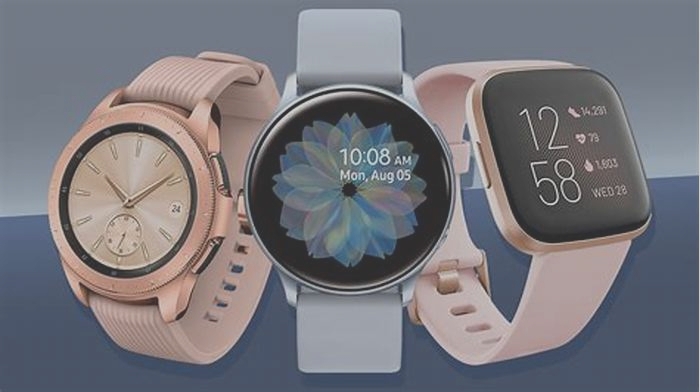Can smart watches cause headaches

Wearable Hacks
Wearing a tiny computer on your wrist has endless benefits. For example, the recently concluded four-year Apple Heart Study by Stanford and Apple revealed that the Apple Watch could detect atrial fibrillation and other types of heartbeat irregularities. However, despite these benefits, a smartwatch also has some side effects.
The radiation and blue light emitted by a smartwatch can cause serious side effects in some people. As a result, you may experience dizziness, headache, nausea, insomnia, or body dysmorphia. It is advisable to use covers to protect against radiation and have self-control in using smartwatches to overcome the side effects.
For instance, you should stop using your smartwatch two hours before going to bed. Although most smartwatches allow for sleep monitoring, I recommend monitoring your sleep during prescribed days. Taking a shower with a smartwatch can also encourage the rise of bacteria or fungi around your wrist and result in itching.
Read on to find out more about smartwatch side effects and how you can protect yourself against them.
Recommended reading: Is Smartwatch Radiation Harmful?
Smartwatch side effects
It is important to note that the side effects do not occur in every user. Underlying medical conditions or allergies might cause them. Therefore, it is vital to take a haemogram test before wearing a smartwatch to reveal any potential risks in your system that can be made worse by the gadget.
Nevertheless, here are some of the side effects that smartwatch users have frequently reported.
Nausea and headache
These are the significant side effects reported by smartwatch users. Nausea and headaches are a result of adverse reactions to EMF radiations emitted by smartwatches. If you had never used a smartwatch before and experienced these symptoms following your first use; the smartwatch might be the reason.
Try taking it out for a few days and monitor your bodys reaction without a smartwatch. Note, however, that not everyone experiences these symptoms. For example, I know of a friend who uses the Apple Watch, but the girlfriend cannot because of severe nausea.
Insomnia
Users obsessed with using smartwatches go to sleep with the watch and wake up early to continue using it. According to the UC Davis Eye Center, overexposure to blue light emitted by smartwatches hurts the eyes and interferes with our sleep cycles.
Blue light regulates the circadian rhythm, which is critical for controlling natural waking and sleeping cycles. Prolonged smartwatch screen time causes eye strain which could damage the retinal cells, contribute to cataracts, and promote age-related macular degeneration.
Insomnia can lead to memory issues. That is, overusing your smartwatch may result in forgetfulness due to the lack of concentration it promotes. Additionally, this may lead to constant exhaustion, which may hamper your professional life.
Body dysmorphia
Body dysmorphia as a side effect occurs when a smartwatch user does everything, including eating while going through notifications. You should not approach the dining table with your smartwatch if you are that type of person.
According to psychologists, the brain can only concentrate on one task at a time eating or using a smartwatch. If you multitask, your brain will not recognize when you are satisfied or need more food.
Therefore, eating while using a smartwatch can cause severe overeating since your attention is on the device rather than the food. The side effect is that you acquire a body that you are not proud of, called body dysmorphia.
Distractions
It is effortless to bring your wrist to your face to look at the time or read notifications. There are also several apps you can install in a smartwatch that can keep you preoccupied. Getting used to a smartwatch is as addictive as phone usage among teenagers.
This kind of distraction can result in antisocial behavior, where one is so busy with their smartwatch that they neglect their friends and loved ones during quality time.
As a result, you may get distracted even in situations that require your full attention. An example is distractive driving. The study conducted by The Conversation Africa Inc. revealed that smartwatch use among drivers reduces their ability to assess and react to a problem.
An awareness of the side effects of smartwatches is key to avoiding distractions and ensuring optimal focus on the task at hand.
How to reduce smartwatch side effects
According to the United States Environmental Protection Agency, you can protect yourself against radiation in three ways: Limiting time, increasing distance, and using a shield. On the other hand, you can exercise to exhaustion to have natural periods of sleep uninterrupted by smartwatches to help with insomnia.
Here are the ways to reduce smartwatch side effects;
Use your smartwatch to exercise
Health and fitness tracking are one of the reasons smartwatches are essential. Smartwatch side effects like insomnia and body dysmorphia can be controlled by frequent exercises. You can track your sleep using a smartwatch and analyze your sleep patterns and progress.
A smartwatch tracks activities such as running, jogging, biking, swimming, and walking. When your body gets tired from the exercises, you will naturally fall asleep earlier and avoid using the smartwatch late into the night.
Disconnect smartwatch from the smartphone
This is particularly important if you want to avoid distractions when you are on something important. Remember that most smartwatches are not autonomous and thus require a connection to a smartphone to provide notifications.
By disconnecting your smartwatch from the smartphone, you limit the functionality of the smartwatch. Thus, the probability of causing accidents due to distracted driving is reduced. Similarly, you can turn on airplane mode to keep you free from radiation until you need to use the smartwatch again.
Set a routine
Sticking to a plan can be challenging but setting a routine will be rewarding in the long run. For example, I do not use my smartwatch all the time. There are places, events, and circumstances under which I can wear it.
Setting a routine for when to wear your smartwatch will keep you away from the compounding side effects of radiation. Decide when your smartwatch is very necessary and use it during those times.
Summary
Smartwatches have countless benefits, from tracking our steps to monitoring our heart rates. However, not everyone can enjoy the flexibility of having one because of its side effects. If your body has shown resistance against smartwatches and you like them, you can still purchase one.
To protect yourself from the side effects, make it a habit to exercise and use your smartwatch to analyze and make changes to your sleeping patterns. That will prevent insomnia. You can set a routine to abstain from the smartwatch during certain times to reduce EMF radiation exposure.
Can Fitbit cause headaches?
Last updated on January 6th, 2023 at 12:06 pm
Can Fitbit cause headaches? The technology is undoubtedly designed to improve health, but is it possible it has negative effects too?
Fitbit is a company that markets fitness technology products. The company deals with a broad range of products, each having a slight difference in features.
The main purpose of the devices is to track steps and activity.
The most widely used ones are worn like watches while the older models used were clipped onto the clothing. Fitbits can be compared to a basic school pedometer.
Although Fitbits are embedded with a whole lot of advanced features, besides the fact that they are more accurate too.
From tracking sleep patterns to monitoring oxygen levels in the body, a Fitbit is a complete fitness tracker for the human body. Not just regulating, Fitbit bands are also conducive to regulating sleep.
The fact that this device can track the heart rate too, can be a major life-saver at times.
Keeping in view the numerous benefits, this device has been a major demand for the last couple of years. But like everything that finds its existence on the planet, technology has two facets.
From an extreme obsession with the technology to its adverse effects on the body, Fitbits have been sometimes known to bring discomfort too.
What are the Side Effects of Wearing a Fitbit?
Fitbits are electrical devices. There is a probability that they might cause injury if not handled properly.
A report from CBS New York claimed that a person experienced electric shock waves while the device was still on.
The wave left a sore lump on his wrist & a temporary numbness in his hand.
Studies have also proved that the use of fitness trackers triggers a dopamine rush in the body, that in turn, might induce feelings of
- Anxiety
- panic
- Sadness and
- Guilt
Besides the fact that this device can cause compulsive behavior, it might also be the cause of eating disorders.
Quite often the undue dietary restraints by the tracker take a toll on the body leading to inappropriate eating habits.
Counting the cons of a Bluetooth device would be incomplete without bringing up EMF Exposure. A Bluetooth appliance uses radiofrequency EMF for connection.
The proximity between the body and the band along with prolonged usage leads to a voluminous emission of EMF which is known to cause biological triggers in the body.

Can Smartwatches give you Headaches?
Wearing a smartwatch 24*7 is likely to be the cause of prolonged EMF radiation.
These radiations induce headaches. Here is how a Fitbit band can cause headaches
A lot of users monitor their sleeping cycle patterns by putting them on while they sleep.
Besides the fact that radiation might be a deterrent to sound sleep, being over-conscious of the band remarks might disturb sleep routine too.
And a disturbed sleep routine is a major cause of headaches.
Fitbit users are often habitual of examining their band remarks every other minute. While that may keep the user up-to-date with their inner functioning, on the flip side, it also leads to distractions at work.
Inconsistency and disorientation at work and in personal life result in a headache.
If someone is experiencing a headache for a good part of the day repeatedly then a key factor could be exposure to the device radiation.
Can Fitbit Trackers cause Muscle Pain?
Fitbit trackers can be a great tool for getting ourselves into great shape.
While they directly dont do anything, they sure act as great reminders for actions and precautions. But these trackers have even a dark side that concerns our muscles.
- The muscles of the band area start to lose their strength due to the consistent pressure thats exerted by the fingers and the hand.
- The fact that there is constant pulling while the band is on, puts the joints & the muscles under more pressure. And that, in turn, leads to stiffness in the muscles.
- Wearing a Fitbit makes the user utilize their upper body more.And for some reason, it is against natural human physiology. It makes your body push with more effort wherever it is strapped in the body.
So apparently, Fitbit trackers can be a major cause of muscle pain. But if used with a certain relaxation, the pain and discomfort could be surely averted.
Fitbit Tingling and Dizziness
About two years back one of the users of the Fitbit band shared a concerning report in the Fitbit community.
According to him, he experienced some strange tingling sensations while he was working out on the treadmill at a moderate speed of 4.3 mph.
While getting examined at the doctors there seemed no signs of heart attack or anything off track.
There are even more instances where Fitbit users complained of dizziness and heavy heads while the band was on. There is not any specific evidence that proves the tracker is the culprit.
But it is believed that the rays can sometimes take over the neural system of the body under certain extreme internal and external situations.
Can Fitbit cause Breast Cancer?
Several studies have examined cases and come up with the conclusion that there is no direct nexus between breast cancer and the usage of Fitbit.
Even the NCI states that all the carcinogenic claims made against Fitbits have been debunked. And it goes on to say that more research is needed on cell phones because technology is changing rapidly.
However, the fact that the results are in our favour doesnt mean the worst couldnt be assumed. Blue rays and EMF radiations are subject serious enough for every concerned being.
Can Wearing Fitbit cause Hair Loss?
There are a lot of causes that lead to hair loss. One of the medically proven ones is-
- Hormonal Conditions (especially in women)
- Medications
- Emotional Stress
- Poor Nutrition
- Infections &
- Medical Conditions (say, Lupus)
No studies havent yet proven that Fitbits can be a reason behind hair loss. Although there is a possibility that the material used in the band might cause an allergy to the scalp.
As for precaution, any treatment that causes inflammation of hair follicles must be avoided for one to contain the loss.
FAQ Related to Fitbits and Headaches
Image Source
Devices like Fitbits have been a major topic ever since their inception. Not only are they helping us track our medical conditions but proving to be a breakthrough in the health & fitness line.
Here are a few frequently asked questions related to the device.
What do Fitbits do?
A Fitbit is a fitness tracker that records data based on daily activities and exercise. Although the exact feature varies from model to model.
But almost all bands can record the steps one takes, their heart rate, O2 rate etc.
Does Fitbit Directly cause a Headache?
EMR exposure is the major cause of uncomfortable experiences like headache, nausea, irritation etc. It is advised to turn the airplane mode on and maintain a distance from the device every day for a certain time to lessen the exposure.
How Does Overdependence on the Device Fails Its Purpose?
Even though the device is a means of keeping the track of ones inner workings, it has a flip side.
The overdependence on it can distract ones focus from the achievement of a fit mind and body to dependency on data and records. Its domino effect can be witnessed in both personal and professional life.
Is Fitbit Radiation Harmful?
A Fitbit is connected to your smartphone by Bluetooth. Bluetooth is an electronic magnetic wave, further classified as a microwave that can penetrate human skin.
These waves have high frequency & short wavelengths. Even though a short-term exposure might just be negligible, a prolonged frontage can lead to differential effects on the cells and genes.
Some users even experience Electromagnetic Hypersensitivity Syndrome (EHS) which is a condition caused by over-susceptibility to the rays.
Syndromes like these may not manifest themselves immediately, but unfortunately, they have the potential to alter the intricate biological structuring of the human body.
Does a Smartwatch Cause Headaches?
Dizziness, nausea and headache might be a common experience among people who wear smartwatches all day long and even go on to track their sleep patterns by wearing them all night.
Wearing smartwatches during sleep raises hindrances in the normal sleep cycle and the blue light hurts the eyes.
Blue light has been proven to regulate the circadian cycle of the body. Overexposure leads to deregulation of natural functioning, headache is one of the results.
Do Fitbits Give You Radiation?
The radiation emitted from Fitbit trackers is minimal. The maximum output ranges somewhere from 0.5 to 1% output of the cell phone power.
Bluetooth emits between the range of 800MHz to 2 GHz which is also believed to be negligible to the human body.
However, the combined prolonged emissions from both the Fitbit and the cell phone can be the alarming cause of the unnatural functionality of the cells and the brain.
Considering all the facets of the device, there may not be any absolute justification for the disadvantages of Fitbit usage.The only factors that one needs to consider include the period for which it has been used, extreme external conditions and the noticeable inner mechanisms.









